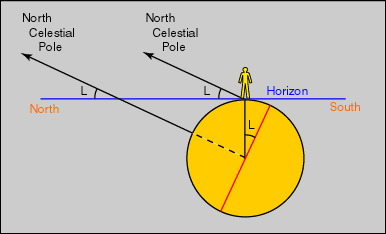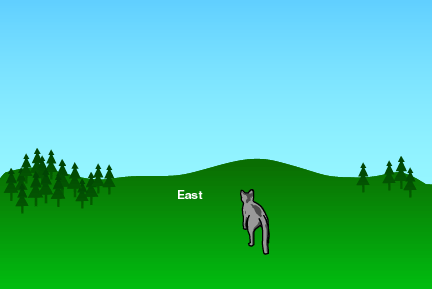In this chapter, we will discuss the apparent motion of the heavenly
bodies. We will understand why the Sun, the Moon and the planets
``move,'' but stars do not.
 Motion of Stars
Motion of Stars
Everyone knows that the Sun rises from the east and sets in
the west. Less well known is that almost everything on the sky, including
the Moon, planets and most of the stars, also rises from the east and sets
in the west. This is the major movement of objects on the sky and it
is due to the rotation of the Earth.
 We could imagine that the Earth is at the center of a large sphere,
called the celestial sphere; and the Sun,
stars, etc. are located on the
sphere. Because the Earth is rotating from the
west to the east, everything on the celestial sphere will
apparently move from the east to the west. This is why the
Sun rises from the east.
We could imagine that the Earth is at the center of a large sphere,
called the celestial sphere; and the Sun,
stars, etc. are located on the
sphere. Because the Earth is rotating from the
west to the east, everything on the celestial sphere will
apparently move from the east to the west. This is why the
Sun rises from the east.
From the picture, we can see that those stars near the north
celestial pole never set. We call them circumpolar stars.
One of the circumpolar star, called Polaris,
is special because it is very near the north
celestial pole. Thus, it appears to be stationary.
 The position of Polaris relative to the ground depends on the
latitude of the observer. For example, for people in
Hong Kong, Polaris will be about 22.4° above the ground due
north.
The position of Polaris relative to the ground depends on the
latitude of the observer. For example, for people in
Hong Kong, Polaris will be about 22.4° above the ground due
north.
Similarly, some stars never rise. People in
the northern hemisphere can never see stars near the
south celestial pole, and people on the southern hemisphere
can never see Polaris. Poor southerners, there is no
bright star near the south celestial pole.
Here are three simulations of what can be seen in the
northern hemisphere. The first one
is pointing to the north. (Note that Polaris does move a little
bit.) The second and the third show the motions of stars at south and the
east respectively.

 Motion of the Sun
Motion of the Sun
Stars do not move on the celestial sphere. They are fixed.
Thus, if we throw away the rotation of the Earth, stars are
stationary. (Note: The truth is that some stars do
move on the celestial sphere. We call this the proper
motion of stars. Usually, proper motion of a star
is very small and can only be detected if we observe the
star for decades.)
There is one important exception however.
The Sun is also a star, but the Sun does move on the
celestial sphere because the Earth revolves around it.
It moves from west to east, and completes a full
circle in a year.
The path that the Sun traces out on the celestial sphere is called the
ecliptic and the twelve constellations
that the Sun goes through are the zodiac.
(Note: Ecliptic does also go through the constellation Ophiuchus,
but due to historical reason, it is not included in the zodiac.)
These are the origin of zodiac in astrology. Contrary to
common belief, the Sun does not spend equal time on
each ecliptic constellation.

Question: What is a day?
Answer: Most people will define a day as the time the Sun
comes back to the same position relative to the ground, for
example, from one midday to another. This is exactly how the
sundial works. This defines the solar day. There is
another less common definition. We call it a day if other stars come
back to the same positions. This is the sidereal day. Due to the
revolution of the Earth, a solar day is longer than a sidereal
day. Approximately, a year has 365 solar days but 366
sidereal days. Do you know why?

We say ``approximately'' because a year has 365.2422 solar days.
To compensate the extra 0.2422 days, some years will have 365 days while
some years, called leap years, will have 366 days.
One extra day is added to the end of February every four years.
By doing this, we are adding too much. Hence, this extra day will not be
added every hundred years, and it will be
added again every four hundred years. For example, we have
February 29 in the years 1988, 1992, 1996, 2000, 2400, 2800, etc., but
there will be no February 29 in the years 1997, 1998, 1999 and
1800, 1900, 2100, 2200, etc. This is called the Gregorian
calendar. Using Gregorian calendar, the error accumulated in
the next 3000 years will not be more than 1 solar day.
The apparent motion of the Moon is similar. The time between
successive full Moons is the synodic month,
it is 29.5 days long. Note that the Chinese
calendar is based on both the motions of the Moon and the Sun, not
just the Moon.
We have not done with the Sun yet. Since the rotational axis
of the Earth is tilted from the revolution axis by 23.5°,
the Sun, for example, rises at different directions at
different times during the year.

Similar to the equator on Earth, we have the celestial
equator on the celestial sphere. The ecliptic will intersect
the equator with an angle 23.5°. The two intersection points
are the vernal equinox and
autumnal equinox. The two points on the ecliptic which are farthest
away from the equator are the summer solstice
and winter solstice. Usually, the Sun passes through
vernal equinox, summer solstice, autumnal equinox and winter solstice on
March 21, June 21, September 21 and December 21
respectively. When the Sun is at the summer solstice, it shines
above the northern hemisphere. The northern hemisphere will receive
more sunlight and become hotter, hence the summer for the northern
hemisphere. Note that in southern hemisphere, it is winter
when the Sun is at summer solstice.
When the Sun is at the summer solstice, it rises at the
northest point and when it is at the winter solstice, it rises
at the southest point. That's why we have long daylight and
short shadow in summer while the opposite in winter.


 Motions of Planets
Motions of Planets
To ancient people, planets were ``stars'' that moved on the celestial
sphere. Actually, they move because they also orbit around the Sun. There are
nine major planets: Mercury, Venus, Earth, Mars, Jupiter, Saturn,
Uranus, Neptune and Pluto, and many minor planets.
Mercury and Venus are the inner planets
because their orbits are inside the orbit of the Earth. Thus,
when watching from the Earth, they are never too far away from the Sun.
They just swing from the east of the Sun to the west and back,
and we can only see them just before sunrise or just after sunset.
Since Venus is the third brightest object (after the Sun and the
Moon) in the sky, we have special names for it.
During the period that we can see it before sunrise,
we call it the ``morning star''. It lasts for about 100 days. When we
can see it after sunset, we call it the ``evening star''.


The others (Mars, Jupiter, Saturn, Uranus, Neptune and Pluto)
are called the outer planets. Due to their own revolutions,
they move from west to east most of the time. We call it the
prograde motion. Because the orbital speed of the
Earth is larger, it sometimes ``catches up'' the outer
planets. Apparently, they will move in the opposite direction,
from east to west. We call it the retrograde motion. (Inner planets
also have both prograde and retrograde motions.) Normally, the
retrograde motion of one outer planet will last from weeks to months.
So, you cannot see it in a single night.

 We could imagine that the Earth is at the center of a large sphere,
called the celestial sphere; and the Sun,
stars, etc. are located on the
sphere. Because the Earth is rotating from the
west to the east, everything on the celestial sphere will
apparently move from the east to the west. This is why the
Sun rises from the east.
We could imagine that the Earth is at the center of a large sphere,
called the celestial sphere; and the Sun,
stars, etc. are located on the
sphere. Because the Earth is rotating from the
west to the east, everything on the celestial sphere will
apparently move from the east to the west. This is why the
Sun rises from the east.








